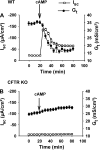A guide to Ussing chamber studies of mouse intestine
- PMID: 19342508
- PMCID: PMC2697950
- DOI: 10.1152/ajpgi.90649.2008
A guide to Ussing chamber studies of mouse intestine
Abstract
The Ussing chamber provides a physiological system to measure the transport of ions, nutrients, and drugs across various epithelial tissues. One of the most studied epithelia is the intestine, which has provided several landmark discoveries regarding the mechanisms of ion transport processes. Adaptation of this method to mouse intestine adds the dimension of investigating genetic loss or gain of function as a means to identify proteins or processes affecting transepithelial transport. In this review, the principles underlying the use of Ussing chambers are outlined including limitations and advantages of the technique. With an emphasis on mouse intestinal preparations, the review covers chamber design, commercial equipment sources, tissue preparation, step-by-step instruction for operation, troubleshooting, and examples of interpretation difficulties. Specialized uses of the Ussing chamber such as the pH stat technique to measure transepithelial bicarbonate secretion and isotopic flux methods to measure net secretion or absorption of substrates are discussed in detail, and examples are given for the adaptation of Ussing chamber principles to other measurement systems. The purpose of the review is to provide a practical guide for investigators who are new to the Ussing chamber method.
Figures











Comment in
-
Shedding gloomy light into the black box of the Ussing chamber.Am J Physiol Gastrointest Liver Physiol. 2009 Oct;297(4):G858-9. doi: 10.1152/ajpgi.00242.2009. Am J Physiol Gastrointest Liver Physiol. 2009. PMID: 19797238 No abstract available.
References
-
- Akiba Y, Furukawa O, Guth PH, Engel E, Nastaskin I, Kaunitz JD. Acute adaptive cellular base uptake in rat duodenal epithelium. Am J Physiol Gastrointest Liver Physiol 280: G1083–G1092, 2001. - PubMed
-
- Argenzio RA, Whipp SC. Effect of theophylline and heat-stable enterotoxin of Escherichia coli on transcellular and paracellular ion movement across isolated porcine colon. Can J Physiol Pharmacol 61: 1138–1148, 1983. - PubMed
-
- Binder HJ, Rawlins CL. Electrolyte transport across isolated large intestinal mucosa. Am J Physiol 225: 1232–1239, 1973. - PubMed
-
- Binder HJ, Sandle GI. Electrolyte absorption and secretion in the mammalian colon. In: Physiology of the Gastrointestinal Tract, edited by Johnson LR. New York: Raven, 1987, pp. 1389–1418.
Publication types
MeSH terms
Grants and funding
LinkOut - more resources
Full Text Sources
Other Literature Sources

